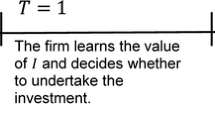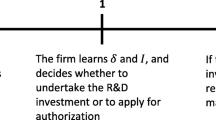Abstract
This paper analyzes the decision of a health authority to implement personalized medicine. We consider a model in which the health authority has three possibilities. It can apply either the same treatment (a standard or a new treatment) to the whole population or implement personalized medicine, i.e., use genetic information to offer the most suitable treatment to each patient. We first characterize the drug reimbursement contract of a firm producing a new treatment with a companion genetic test when the firm can undertake an effort to improve drug quality. Then, we determine the conditions under which personalized medicine should be implemented when this effort is observable and when it is not. Finally, we show how the unobservability of effort affects the conditions under which the health authority implements personalized medicine.



Similar content being viewed by others
Notes
For example, Tardif et al. (2016) analyze the effects of dalcetrapid, a cardiovascular disease-fighting agent, that depend on the genetic characteristics of individuals. They show that the benefits and side effects of this drug depend on whether patients present an AA or a GG genotype. Dalcetrapid seems to be more beneficial for patients with an AA genotype, whereas it may increase the risk of future cardiovascular events in patients with the GG variant of the ADCY9 gene.
Empirical studies [(Bertucci et al. (2000) and (2006)] show that the probability of patients belonging to the group \(\lambda \) deriving a large health benefit from the new treatment may be higher than the probability of patients amenable to the standard treatment receiving a large health benefit when they are administered their best treatment.
In the following, P(1) will be denoted as \(P_{1}\) and P(0) as \(P_{0}\).
Cf. Faulkner et al. (2012).
See for example Belleflamme and Peitz (2015) for developments on complementary innovations in Industrial Organization.
Cf. e.g. Jørgensen (2019) who recalls that the FDA has, for years, recognized that the codevelopment of companion diagnostics and therapeutic products is critical to the advancement of PM and that both products have to be available at the same time.
See Principles for Codevelopment of an In Vitro Companion Diagnostic Device with a Therapeutic Product. Draft Guidance for Industry and Food and Drug Administration Staff. Document issued on: July 15, 2016.
See Barros (2011) for an analysis of risk sharing agreements.
References
Annemans, L., Redekop, K., & Payne, K. (2013). Current methodological issues in the economic assessment of personalized medicine. Value Health, 16(6), 20–26.
Antoñanzas, F., Juárez-Castellá, C. A., & Rodríguez-Ibeas, R. (2015). Some economics on personalized and predictive medicine. European Journal of Health Economics, 16(9), 985–994.
Antoñanzas, F., Juárez-Castellá, C. A., & Rodríguez-Ibeas, R. (2016). Implementing personalized medicine with asymmetric information on prevalence rates. Health Economics Review, 6, 35.
Antoñanzas, F., Rodrí-guez-Ibeas, R., & Juárez-Castellá, C. A. (2018). Personalized medicine and pay for performance: Should pharmaceutical firms be fully penalized when treatment fails? PharmacoEconomics, 36(7), 733–743.
Antoñanzas, F., Juárez-Castellá, C. A., & Rodrí-guez-Ibeas, R. (2019). Pre-approval incentives to promote adoption of personalized medicine: A theoretical approach. Health Economics Review, 9, 28.
Barros, P. P. (2011). The simple economics of risk sharing agreements between the NHS and the pharmaceutical industry. Health Economics, 20, 461–470.
Belleflamme, P., & Peitz, M. (2015). Industrial organization: markets and strategies. Cambridge: Cambridge University Press.
Bertucci, F., Houlgatte, R., Benziane, A., Granjeaud, S., Adélaïde, J., Tagett, R., et al. (2000). Gene expression profiling of primary breast carcinomas using arrays of candidate genes. Human Molecular Genetics, 9(20), 2981–2991.
Bertucci, F., Finetti, P., Cervera, N., Maraninchi, D., Viens, P., & Birnbaum, D. (2006). Gene expression profiling and clinical outcome in breast cancer. Omics, 10(4), 429–443.
Cournot, A. A. (1838). Recherches sur les principes mathématiques de la théorie des richesses (Researches into the Mathematical Principles of the Theory of Wealth). NT Bacon: Initially published. in French.
Danzon, P., & Towse, A. (2002). The economics of gene therapy and pharmacogenetics. Value in Health, 5(1), 5–13.
Danzon, P., & Towse, A. (2003). Differential pricing for pharmaceuticals: Reconciling access. R&D and patents, International Journal of Healthcare Finance and Economics, 3, 183–205.
Danzon, P., Towse, A., & Mestre-Ferrandiz, J. (2015). Value-based differential pricing: Efficient prices for drugs in a global context. Health Economics, 24, 294–301.
Faulkner, E., Annemans, L., Garrison, L., Helfand, M., Holtorf, A.-P., Hornberger, J., et al. (2012). Challenges in the development and reimbursement of personalized medicine-payer and manufacturer perspectives and implications for health economics and outcomes research: A report of the ISPOR Personalized Medicine Special Interest Group. Value in Health, 15(8), 1162–1171.
Garrison, L. P., & Austin, M. F. (2007). The economics of personalized medicine: A model of incentives for value creation and capture. Drug Information Journal: DIJ/Drug Information Association, 41(4), 501–509.
Garrison, L. P., & Towse, A. (2014). Economics of personalized medicine: Pricing and reimbursement policies as a potential barrier to development and adoption, Economics of. In Anthony J. Culyer (Ed.), Encyclopedia of Health Economics (Vol. 2, pp. 484–490). Amsterdam: Elsevier.
Garrison, L. P., & Towse, A. (2017). Value-based pricing and reimbursement in personalized healthcare: Introduction to the basic health economics. Journal of Personalized Medicine, 7(3), 1–10.
Goetz, L. H., & Schork, N. J. (2018). Personalized medicine: motivation, challenges, and progress. Fertility and Sterility, 109(6), 952–963.
Hatz, M. H. M., Schremser, K., & Rogowski, W. K. (2014). Is individualized medicine more cost-effective? A systematic review, PharmacoEconomics, 32(5), 443–455.
Hendricks-Sturrup, R. M., & Lu, C. Y. (2019). Understanding implementation challenges to genetic testing for familial hypercholesterolemia in the United States. Journal of Personalized Medicine, 9(1), 9.
Hornberger, J., Cosler, L. E., & Lyman, G. H. (2005). Economic analysis of targeting chemotherapy using a 21-gene RT-PCR assay in lymphnode-negative, estrogen-receptor-positive, early-stage breast cancer. American Journal of Managed Care, 11, 313–324.
Kirchheiner, J., Bauer, S., Meineke, I., et al. (2002). Impact of CYP2C9 and CYP2C19 polymorphisms on tolbutamide kinetics and the insulin and glucose response in healthy volunteers. Pharmacogenetics, 12(2), 101–109.
Jørgensen, J. T. (2019). Regulatory Requirements for Companion Diagnostics and Drug-Diagnostic Codevelopment in the United States. In Companion and Complementary Diagnostics (pp. 307–318). Academic Press.
Knowles, L., Luth, W., & Bubela, T. (2017). Paving the road to personalized medicine: recommendations on regulatory, intellectual property and reimbursement challenges. Journal of Law and the Biosciences, 4(3), 453–506.
Lam, Y.W. (2013). Scientific challenges and implementation barriers to translation of pharmacogenomics in clinical practice, ISRN pharmacology, Article ID 641089, 17 pages.
Lièvre, A., Bachet, J. B., Le Corre, D., et al. (2006). KRAS mutation status is predictive of response to cetuximab therapy in colorectal cancer. Cancer Research, 66(8), 3992–3995.
Miller, I., Ashton-Chess, J., Spolders, H., Fert, V., Ferrara, J., et al. (2011). Market access challenges in the EU for high medical value diagnostic tests. Personalized Medicine, 8(2), 137–148.
O’Donnell, J. C. (2013). Personalized medicine and the role of health economics and outcomes research: Issues, applications, emerging trends, and future research. Value in Health, 16(6), S1–S3.
Postma, M. J., Boersma, C., Vandijck, D., Vegter, S., Le, H. H., & Annemans, L. (2011). Health technology assessments in personalized medicine: illustrations for cost-effectiveness analysis. Expert Review of Pharmacoeconomics and Outcomes Research, 11(4), 367–369.
Principles for Codevelopment of an In Vitro Companion Diagnostic Device with a Therapeutic Product. Draft Guidance for Industry and Food and Drug Administration Staff. Document issued on: July 15, 2016.
Scott Morton, F., & Seabright, P. (2013). Research into biomarkers: how does drug procurement affect the design of clinical trials? Health Management, Policy and Innovation, 1(3), 1–15.
Tardif, J. C., Rhainds, D., Brodeur, M., Feroz Zada, Y., Fouodjio, R., Provost, S., et al. (2016). Genotype-dependent effects of dalcetrapib on cholesterol efflux and inflammation: Concordance with clinical outcomes. Circulation: Cardiovascular Genetics, 9(4), 340–348.
Towse, A., & Garrison, L. P. (2013). Economic incentives for evidence generation: promoting an efficient path to personalized medicine. Value in Health, 6(6), S39–S43.
Trusheim, M. R., & Berndt, E. R. (2012). Economic challenges and possible policy actions to advance stratified medicine. Personalized Medicine, 9(4), 413–427.
Author information
Authors and Affiliations
Corresponding author
Additional information
Publisher's Note
Springer Nature remains neutral with regard to jurisdictional claims in published maps and institutional affiliations.
We are very grateful to two anonymous referees and to the editor for helpful comments. The usual disclaimer applies.
Rights and permissions
About this article
Cite this article
Alcenat, S., Maréchal, F. & Naegelen, F. Implementation of personalized medicine in a context of moral hazard and uncertainty about treatment efficacy. Int J Health Econ Manag. 21, 81–97 (2021). https://doi.org/10.1007/s10754-020-09290-2
Received:
Accepted:
Published:
Issue Date:
DOI: https://doi.org/10.1007/s10754-020-09290-2




